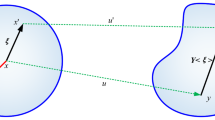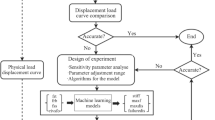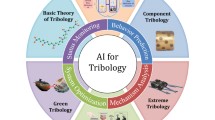Abstract
An artificial neural network model was established to predict the ultimate bearing capacity of aluminum alloy plate joints under compression-bending state. The input parameters of the network are composed of bolt diameter (R), flange plate thickness (T) and connecting plate thickness (L). The output parameter is ultimate bearing capacity. In this paper, firstly the finite element calculation results are compared with the experimental results to verify the accuracy of finite element simulation. Then 216 sets of data were obtained using the finite element program ABAQUS, which were used for training, verification and testing of the neural network model. In addition, the influence of sample size on the prediction accuracy of neural network is analyzed, and a structural optimization method combining finite element calculation and neural network prediction is proposed. The results show that the neural network model is accurate and effective in predicting ultimate bearing capacity, and the linear regression correlation coefficient is 0.98438. The data sample can be reduced to a certain extent to save the time costs and computing resources; It is reasonable and efficient to use the method of finite element parameter analysis and artificial neural network prediction to optimize the structure, which broadens the thinking of structure optimization.













Similar content being viewed by others
References
Erdem, H. (2010). Prediction of the moment capacity of reinforced concrete slabs in fire using artificial neural networks[J]. Advances in Engineering Software, 2010(41), 270–276.
Feng, D.-C., Liu, Z.-T., Wang, X.-D., Jiang, Z.-M., & Liang, S.-X. (2020). Failure mode classification and bearing capacity prediction for reinforced concrete columns based on ensemble machine learning algorithm[J]. Advanced Engineering Informatics, 2020(45), 101–126.
Feng Yuan, Wu., Shu, H. K., et al. (2018). Design of aluminum alloy single-layer reticulated shell structure for Pixian Sports Center [J]. Architectural Structure, 48(14), 24–29.
Friedman, J., Hastie, T., Tibshirani, R. The Elements of Statistical Learning[M]. New York, NY, USA: Springer Series in Statistics, 2001.
Guo, X., **ong, Z., Luo, Y., Qiu, L., Liu, J. (2015). Experimental investigation on the semi-rigid behaviour of aluminium alloy gusset joints. Thin Walled Structures, 87, 30–40.
Guo, X., **ong, Z., Luo, Y., Qiu, L., Huang, W. Application of the Component Method to Aluminum Alloy Gusset Joints[J]. Advances in Structural Engineering, 2015, 18(11): 1931–1946.
Hongbo, L., Jiaojie, Y., Yi, M., Zhihua, C. (2019). Flexural behavior of double- and single-layer aluminum alloy gusset-type joints. Thin-Walled Structures, 144(2019), 1–14.
Hongbo liu, Yizhe Ding, Zhihua Chen. Static stability behavior of aluminum alloy singlelayer spherical latticed shell structure with Temcor joints[J]. Thin-Walled Structures, 2017, 120(2017).
Jixiang, X., Zhao, J., Song, Z., & Liu, M. (2012). Prediction of ultimate bearing capacity of Tubular T-joint under fire using artificial neural networks[J]. Safety Science, 2012(50), 1495–1501.
Lian**, Y., Shen, W., Qilin, Z. Research status and key problems of aluminum alloy spatial grid structure. Journal of Building Structure, 2013, 34(2): 1–19, 60.
Lo´pez, A., Puente, I., Miguel, A., & Serna. (2007). Numerical model andexperimental tests on single-layer latticed domes with semi-rigid joints[J]. Computers and Structures, 85(7–8), 360–374.
Momeni, E,. Nazir, R., Jahed, D., Armaghani, Maizir, H. Prediction of pile bearing capacity using a hybrid genetic algorithm-based ANN[J]. Measurement, 2014, 57(2014): 122–131.
Mingzhe shi, ** **ang, Minge Wu. Experimental investigation on bending and shear performance of two-way aluminum alloy gusset joints[J]. Thin-Walled Structures, 2018, 122(2018): 124–136.
Mundfrom, D. J., & Shaw, D. G. (2005). Minimum Sample Size Recommendations for Conducting Factor Analyses[J]. International Journal of Testing, 5(2), 159–168.
padminia, D., Ilamparuthi, K., Sudheer K.P,. Ultimate bearing capacity prediction of shallow foundations on cohesionless soils using neurofuzzy models[J]. Computers and Geotechnics, 2008, 35(2008): 33–46.
Rodríguez-Sánchez, A. E., Ledesma-Orozco, E., & Ledesma, S. (2019). Part distortion optimization of aluminum-based aircraft structures using finite element modeling and artificial neural networks[J]. CIRP Journal of Manufacturing Science and Technology, 2020(1), 1–12.
Ruoqiang, F., **, W., Jie, Z., et al. (2020). Research on the overall stability of prefabricated single-layer aluminum alloy reticular shell structure at Bei**g new airport [J]. Journal of Building Structures, 41(4), 11–18.
Seher, A. (2020). Estimating the Effects of Heat Treatment on Aluminum Alloy with Artificial Neural Networks[J]. Emerging Materials Research, 2020(9), 1–12.
Shuai, Xu., Chen, Z., Wang, X., & Mazzolani, F. M. (2015). Hysteretic out-of-planebehavior of the Temcor joint[J]. Thin-Walled Structures, 2015(94), 585–592.
**ong, Z., Guo, X., Luo, Y., Zhu, S., & Liu, Y. (2017). Experimental and numerical studies on singlelayer reticulated shells with aluminium alloy gusset joints[J]. Thin-Walled Structures, 2017(118), 124–136.
Xuefeng, Z., Jiachun, C., Jian, Y. (2008). Design of large-span free-form surface aluminum alloy reticular shell structure for the large dome of Foding Palace in Niushoushan Cultural Tourism Area in Nan**g. Building Structure, 48(14), 8–13.
Yaming, Li., Haitao, J., Shuizhong, J., et al. (2018). Structural design of aluminum alloy reticulated shell with inverted dome of Shanghai Planetarium [J]. Architectural Structure, 48(14), 30–33.
Yue, J. (2018). Application and research status of reticulated shell structure [J]. Structural Engineer, 34(1), 156–163.
Yuxia, Z. (2020). Computation of complex well function based on BP neural network[D]. Hebei University of Engineering.
Zhijie, Z., Ruoqiang, F., Fengcheng, L. Experimental study on aluminum alloy glass roof joints of Bei**g Daxing International Airport[J]. China Civil Engineering Journal, 2020, 53(8): 38–44, 128.
Zhenggang, C., Liang, Li., Tianyang, W., et al. (2020). Finite element analysis of axial tension and compression performance of aluminum alloy hub joints[J]. Journal of Harbin Institute of Technology, 52(8), 184–191.
Zuyan, S., **aonong, G., & Yuanqi, Li. (2007). A brief introduction to the research status of aluminum alloy structure [J]. Journal of Building Structure, 6, 100–109.
Acknowledgements
This paper was financially supported by the National Natural Science Foundation of China (Grant No. 51978151 and 51538002).
Author information
Authors and Affiliations
Corresponding author
Additional information
Publisher's Note
Springer Nature remains neutral with regard to jurisdictional claims in published maps and institutional affiliations.
Rights and permissions
About this article
Cite this article
Zhong, Cj., Feng, Rq. & Zhang, Zj. Prediction of Ultimate Bearing Capacity and Structural Optimization of Aluminum Alloy Plate Joints Based on Artificial Neural Network. Int J Steel Struct 21, 1759–1774 (2021). https://doi.org/10.1007/s13296-021-00533-7
Received:
Accepted:
Published:
Issue Date:
DOI: https://doi.org/10.1007/s13296-021-00533-7




